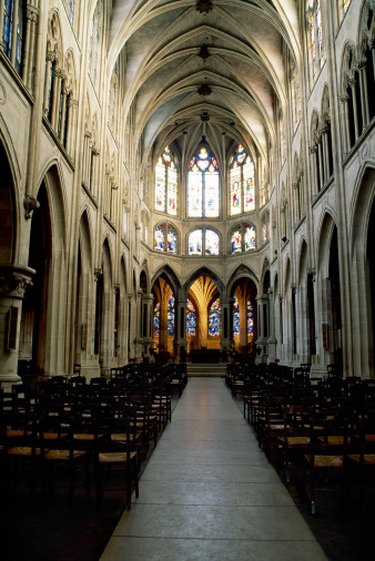
Although the terms Romanesque and Gothic sometimes refer to artwork, most often they describe architectural styles of the Middle Ages. The two styles are very different in overall appearance, with Romanesque seeming heavy and dark, and Gothic appearing airy and ornate. In spite of their differences, both styles are reflected in grand medieval churches, cathedrals and castles.
Medieval Times
Video of the Day
Both styles of architecture were popular in the Middle Ages, although Romanesque occurred first and evolved into Gothic. Pioneered by the Normans but reminiscent of classical Roman architecture, Romanesque style was introduced around 800 A.D. and remained popular through 1100 A.D. At that point, building styles transitioned to the Gothic style, which was popular from the mid-1100's through 1500 A.D. Gothic style, which originated in France, at first was dubbed the French style, but detractors of the ornate, "heavenly" and gargoyle-studded buildings renamed it after the barbaric Goths who sacked ancient Rome.
Video of the Day
Churches and Cathedrals
For examples of Romanesque and Gothic architecture, experts usually point to churches and cathedrals from that era, although some castles and secular buildings also were built in these styles. Romanesque examples include St. Sernin and Mont St. Michel in France, Italy's Cathedral of Pisa and the many "Norman" castles studding much of western Europe. Examples in the Gothic style include England's Westminster Abbey, St. Peter's in Rome, and the Notre Dame Cathedral and Chartres Cathedral in France.
Size and Strength
The structures of both styles were massive, so supportive devices had to be strong enough to maintain heavy ceilings and walls. Those built in the Romanesque style typically employed vaults, buttresses and thick, heavy walls with few windows to provide the sturdiest overall support for heavy walls and ceilings. Improving upon Romanesque supportive techniques, the Gothic style introduced the groin vault and the exterior flying buttress, which redistributed the weight of walls and roof and allowed more and bigger windows.
Arches
Acknowledged as one of the strongest structures used in architecture, the arch was employed in both Romanesque and Gothic styles. They differed most notably in shape, however, with the Romanesque style using rounded arches and the Gothic style including pointed arches.
- Kidipede; Gothic Architecture for Kids; Karen Carr, Ph. D.; March 2011
- Castles: Romanesque Architecture
- Mental Floss: Romanesque vs. Gothic Architecture
- University of Nevada, Las Vegas: Key Characteristics of and Differences Between Carolingian, Romanesque and Gothic Styles and Regional Variations
- MiddleAges.org; Romanesque vs. Gothic Architecture; Mark Hudelson